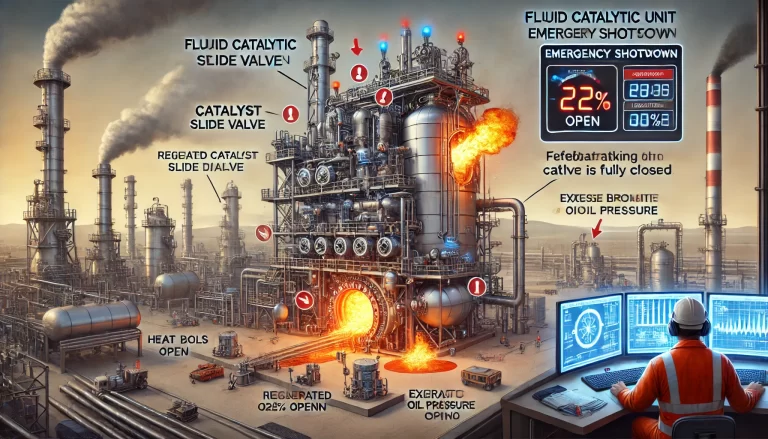1. Background
In a 1 million tons/year Fluid Catalytic Cracking (FCC) unit, the regenerated catalyst slide valve (commonly referred to as the “spent catalyst slide valve”) plays a critical role. It is used to:
Cut off catalyst circulation during startup and shutdown;
Regulate the catalyst circulation rate during normal operation to control stripper level and riser outlet temperature.
This case study describes an incident where improper operation of the slide valve, due to unrecognized hot-state zero-point offset, led to mechanical failure and an emergency shutdown.
2. Equipment Overview
The FCC unit employs a parallel-type heavy oil cracking process with several systems, including reaction-regeneration, fractionation, stabilization, and gas separation. The raw materials are atmospheric and vacuum gas oils.
The slide valve is installed at the bottom of the regenerator, with a full stroke of 600 mm, and is actuated by an ICM electro-hydraulic actuator installed during the 2019 overhaul. The actuator includes a thermal expansion absorption system with a pressure relief valve.
During startup, catalyst temperature may rise from ambient to 700°C. The thermal expansion of the standpipe pushes down the valve seat, causing a change in valve position, which must be accounted for in zero-position calibration.

3. Description of the Incident
Date: Post-2019 overhaul during startup.
Event: When the catalyst temperature reached ~690°C, the operator issued a continuous close command to the slide valve. Suddenly, the actuator detached from the valve body.
Impact: The valve remained fully open, catalyst level dropped rapidly, and the FCC unit was forced into emergency shutdown.
4. Failure Analysis
4.1 Root Causes
Direct Cause: Operator continued to issue close commands after valve was already fully closed, causing overload.
Mechanical Effect: 16 mounting bolts of the actuator sheared due to excessive downward force.
Systemic Cause: Lack of operator training on hot-state zero offset and inadequate collaboration between instrumentation and process departments.
4.2 Diagnostic Review
Historical trend data showed that when the regenerator temperature reached 400°C, the slide valve was already fully closed, yet the valve feedback still indicated 32% open due to thermal expansion.
Operators misinterpreted the feedback and continued to issue close commands, reducing the feedback to 22%, increasing oil pressure in the actuator cylinder.
The pressure relief valve failed to dissipate excess pressure effectively under continuous closing force, leading to bolt failure.
5. Preventive Measures and Recommendations
5.1 Technical Measures
Perform thermal calibration of the valve position after regenerator heating.
Ensure actuator’s pressure relief system is tested according to design specs and documented before delivery.
5.2 Operational Measures
Strengthen training for operators on thermal expansion behavior and zero-offset interpretation.
Include valve zero-offset checks in startup/shutdown procedures.
Use historical trends and feedback loop monitoring to detect abnormal feedback changes.
5.3 Design Recommendations
For valves where cold-hot position offsets are significant, consider structural design improvements or dynamic offset correction algorithms.
Improve inter-departmental collaboration, ensuring that process, instrumentation, and maintenance teams jointly verify startup conditions.

6. Conclusion
This incident highlights the importance of recognizing and compensating for thermal expansion in critical valve systems. Proper operator training, instrumentation feedback interpretation, and effective communication between departments are vital to avoid similar failures. The failure of 16 actuator bolts due to a simple misjudgment underlines the systemic risks posed by knowledge gaps in operation and coordination.
